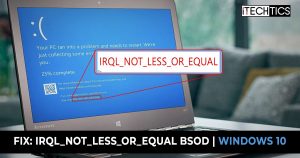If you have or are continuously experiencing a Blue Screen of Death (BSoD) with a stopcode stating “IRQL_NOT_LESS_OR_EQUAL” then this post is for you. Windows 10 is having increasing BSoDs by the day, but we are here to guide you on how to fix them.
IRQL stands for Interrupt Request Level which is a means for Windows to prioritize the interrupts that come from the processor. For instance, if an interrupt is generated by the processor with a greater priority than the processes already executing, the IRQL will put the running processes on hold while executing the process with higher priority.
Table of Contents
The “IRQL not less or equal” BSoD usually comes with the name of the source file causing the error. These could be any one of the following, but not limited to:
- kbdclass.sys
- ntoskrnl.exe
- usbxhci.sys
- ql2300.sys
- epfwwfp.sys
- e1c62x64.sys
- rdbss.sys
- rdyboost.sys
- rtkhdaud.sys
- rtwlane.sys
- tcpip.sys
- tap0901.sys
- tdx.sys
- usbport.sys
- usbhub.sys
- igdkmd64.sys
- netio.sys
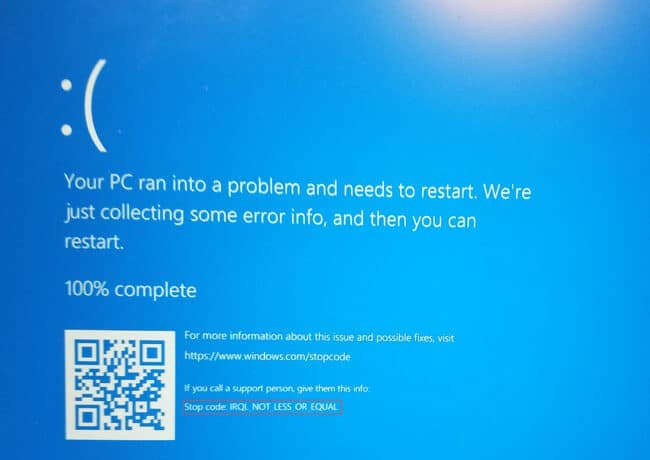
As you may find upon further investigation, the majority of the files associated with the “IRQL not less or equal” BSoD are associated with drivers or devices that have a corrupted driver.
This BSoD occurs when Windows or a kernel-mode driver tries to access a pagefile memory at a process IRQL that was too high and invalid. Under such circumstances, a stopcode is thrown and the blue screen appears while shutting down the computer so that it does not damage any other software or hardware.
The “IRQL not less or equal” BSoD can occur while the computer is attempting to boot or performing a task that involves an invalid driver installation. It is also possible that CPU overclocking may have something to do with the error, or a third-party antivirus is blocking a driver from performing its function properly.
More or less, this error is mostly associated with a faulty piece of software, which is usually a driver, or a configuration which the device cannot handle.
Let us continue to see how we can fix this issue to have a smooth Windows experience.
Fix IRQL Not Less Or Equal BSoD In Windows 10
Determine faulty drivers
The first order of business should be to investigate the file that is said to be the source of the error when the BSoD occurred. Note down the file name and search for the associated driver on the internet. Here is a list of the most commonly corrupted files and their associated drivers:
- kbdclass.sys – Associated with a keyboard driver. Users have reported that the “IRQL no less or equal” error almost instantaneously occurs as soon as they plug in the keyboard. Updating the driver is said to resolve the error.
- ntoskrnl.exe – This executable is responsible for various kernel services like hardware virtualization, etc. It can be associated with a number of different drivers, but users have reported that it is mostly caused by Realtek audio drivers.
- usbxhci.sys – Associated with USB port driver.
- ql2300.sys – Associated with QLogic Fibre Channel Stor Miniport Driver.
- epfwwfp.sys – Associated with ESET Personal Firewall software.
- e1c62x64.sys – Associated with Intel’s network port driver.
- rdbss.sys – This file is associated with Windows OS. Updating your system or fixing the corrupted file is said to have fixed the issue.
- rdyboost.sys – This file is associated with Windows OS. Updating your system or fixing the corrupted file is said to have fixed the issue.
- rtkhdaud.sys – Associated with Realtek HD audio chipset driver.
- rtwlane.sys – Associated with Realtek Wireless LAN driver.
- tcpip.sys – This file is responsible for running the TCP/IP protocol on your device. Resetting the TCP/IP stack or updating your OS has reportedly fixed the issue.
- tap0901.sys – This file is associated with AP-Win32 Adapter V9 or OpenVPN driver or Comodo VPN. It is recommended that you re-install the software to fix the issue.
- tdx.sys – Associated with Broadcom network adapter.
- usbport.sys – Associated with a USB port.
- usbhub.sys – Associated with a USB port.
- igdkmd64.sys – Associated with Intel’s graphics driver.
- netio.sys – Associated with network driver.
If you come across a file other than these, then we suggest you look it up on the internet for further elaboration.
Update/reinstall faulty driver
Once you figure out which driver is causing the “IRQL not less or equal” BSoD, we suggest that you either update it or reinstall it immediately.
To update a malfunctioning driver, open the Device Manager by typing in devmgmt.msc in Run. Now, look for the device with a faulty driver and then right-click it. From the context menu, click Update Driver.
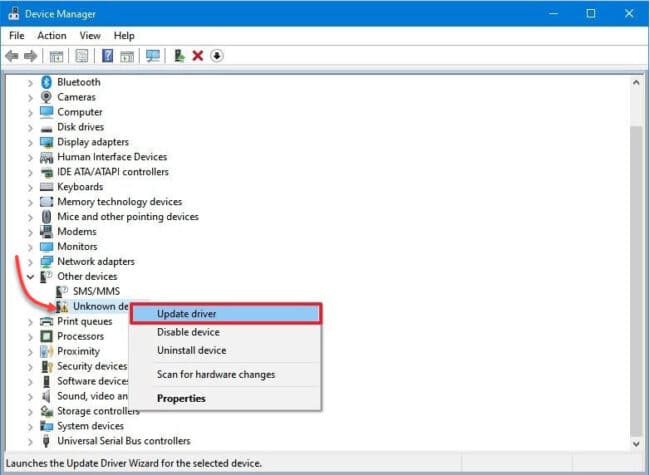
In the pop-up window, click Search automatically for drivers. The wizard will now search online for any updated drivers available. Once installed, restart the computer. However, if the driver update fails, we suggest that you go to the manufacturer’s website and manually download and install the driver package. Or you can also search for and install device drivers automatically.
If the driver cannot be updated, we suggest that you uninstall the device and then reinstall the driver. To do so, open the Device Manager again, right-click the device with the faulty driver and click Uninstall device from the context menu. You will then be asked if you want to remove the driver as well. Check the box and click Uninstall.
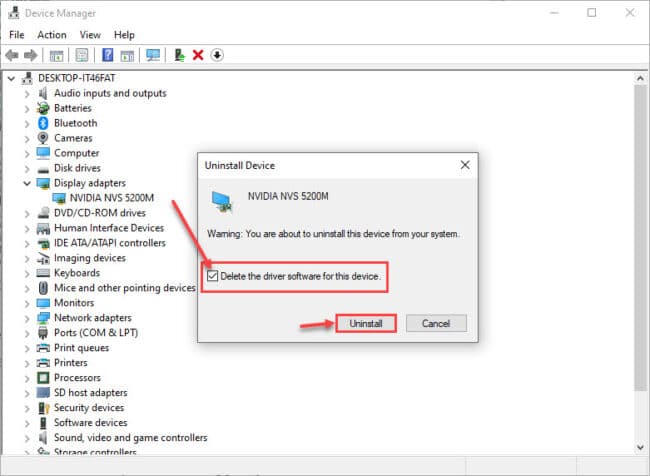
Once removed, reinstall the driver using the manufacturer’s website and you will have a fresh version of the file causing the problem.
Disable/uninstall third-party antivirus software
Antivirus often causes hindrance in the normal functionality of the OS by blocking certain files and items that may seem malicious, but in fact, are not.
Therefore, we suggest that you completely remove any third-party antiviruses, restart the computer, and check if the issue has been resolved. If you do not encounter Blue Screen of Death again, we suggest you do not use the same antivirus again, but go for better, paid software. Alternatively, you can also keep using the Windows Defender Antivirus as well that comes built-in with Windows 10.
Scan for corrupted system files
Windows 10 comes with a built-in tool to fix system files that may have been corrupted. This tool is the System File Checker (SFC) which automatically repairs corrupted system files that may be redundantly available on your PC, or have just gone missing. What it does is replace any damaged or missing files.
Perform the following to run the tool:
- Launch Windows PowerShell with administrative privileges and then enter the following command:
sfc /scannow - Now allow some time for the command to fully run and scan your PC, and make any fixes if possible along the way.
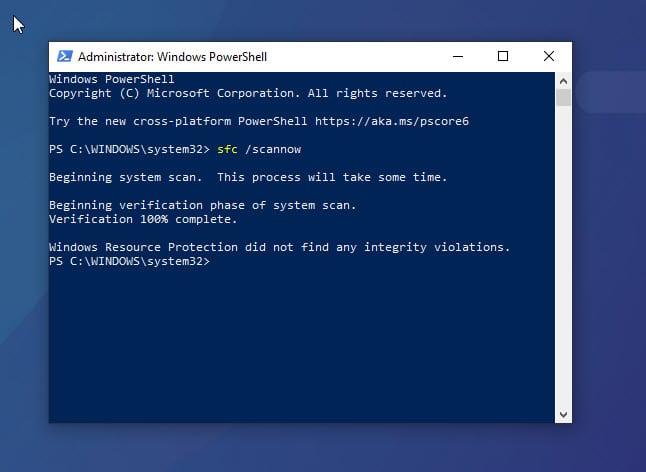
- Restart the computer.
Once done, recheck if the issue persists.
Update your operating system
If you think that the file causing the error is a critical system file, you should also try updating your OS. Often, the update includes a fresh copy of the files and can replace the corrupted ones.
To check for any pending Windows updates, open the Windows Update page in the Settings app and click Check for updates. Windows will now automatically download and install any outstanding updates. Please ensure that they are installed successfully and then restart the computer.
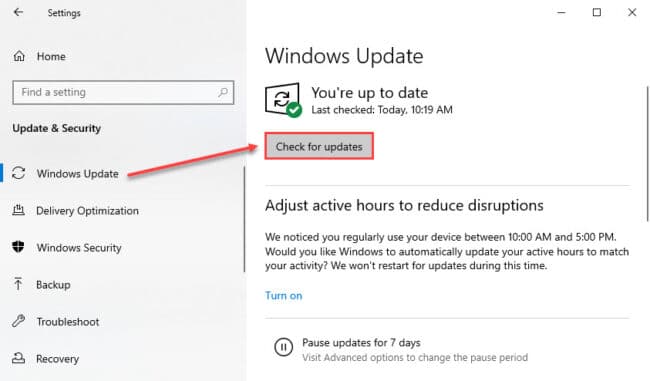
Uninstall the Windows update
A Windows update can often seem to be the problem causing the BSoDs. It can be because of a known issue with the update or an irregular installation as well. A simple solution for this is to uninstall the update altogether. You can remove a Windows update using the following method:
- Open Command Prompt (Run –> cmd)
- Run the following command:
wmic qfe list brief /format:table - This will show all the updates installed on the computer. Make sure the relevant updates are on the list.
- To uninstall the update, run the following command
wusa /uninstall /kb:5000842
Replace the KB number in the command above and restart your computer once the update is uninstalled.
Another method to uninstall a troubling update is through the Control Panel. Open the Programs & Features page in the Control Panel and then click View installed updates on the left. Double-click on the update you want to remove and then click Uninstall when prompted for a confirmation.
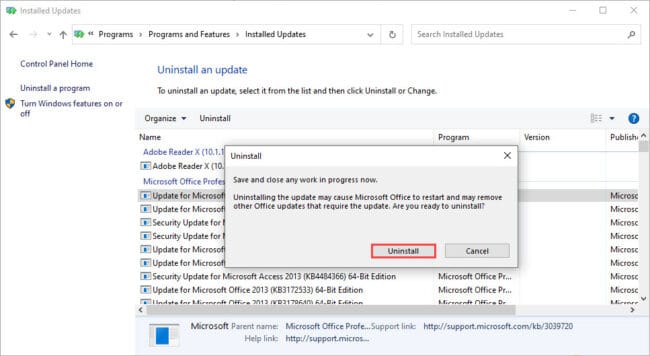
Closing words
Don’t panic when you experience a bluescreen of death; there is most likely a solution out there without having to reinstall your OS entirely.
IRQL not less or equal error could have many originating reasons, as you may have learned from this post. However, it is not impossible to solve the issue.
If you want to learn more about the error, read this support post from Microsoft.


